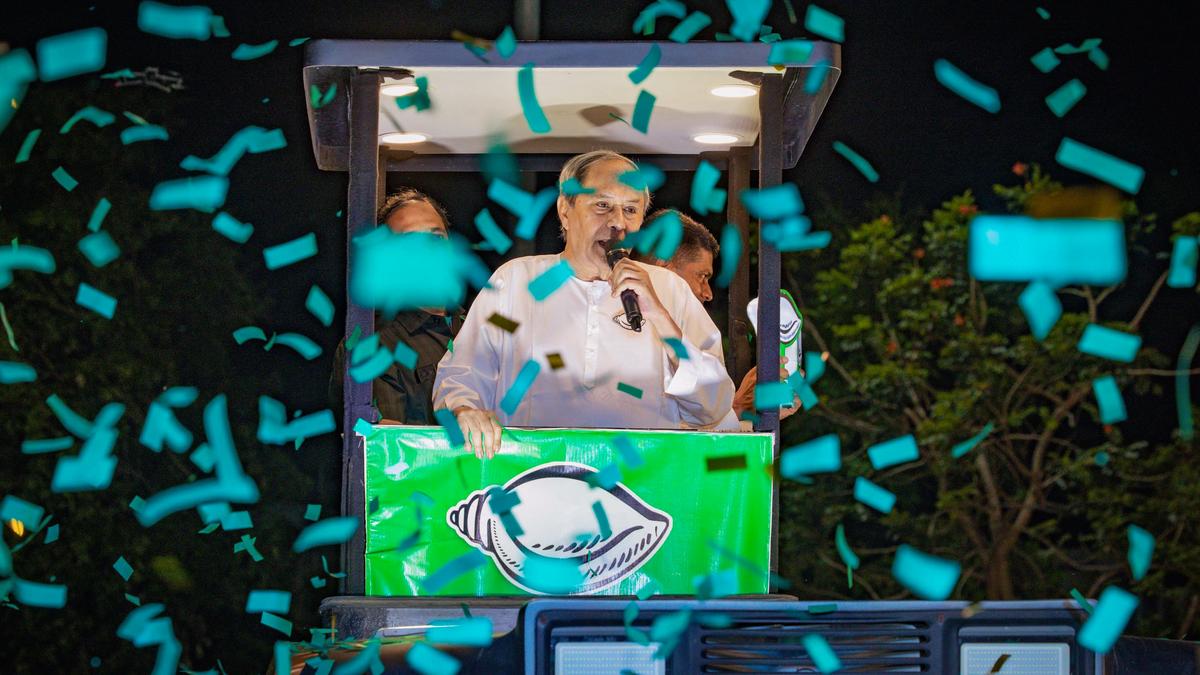
An Odisha fortress and a hard electoral battle Premium
The Hindu
Odisha might go the Maharashtra way, creating conditions for the BJP’s hegemony
In modern India, no other political party has been as consistently aggressive as the Bharatiya Janata Party (BJP) has been election after election in its campaign to expand its social base to all corners of India including Odisha. Not surprisingly, the State has witnessed a campaign blitzkrieg by the BJP’s tall leaders, which includes Prime Minister Narendra Modi who addressed a few meetings just a couple of days before May 13, the first phase of elections in Odisha.
With a consistent decline in its social base, with nine seats out of 147 (Assembly seats) and one in Parliament in the 2019 elections, the Congress party, traditionally a dominant force, has now become an insignificant player. On the other hand, the BJP’s voteshare is at 38.4%, winning eight out of 21 seats in the 2019 parliamentary election, while the ruling Biju Janata Dal (BJD) led by Naveen Patnaik has 42.8%, winning 12 seats. In the 2019 Assembly elections, the voteshare of the BJP was 32.49 % and that of the BJD, 44.71%, respectively. Clearly, the gap between the two parties is closing with each election.
For years, Mr. Patnaik maintained that the BJD’s policy has been to keep an equi-distance from the BJP and the Congress. But his party has conducted itself more as a loyal coalition partner to the Modi government than being independent. Further, the two parties did have discussions to jointly fight the 2024 election, but it did not work out. Set up in 1997, the BJD did have an alliance with the BJP that ended prior to the 2009 elections — the reason being the role of Hindutva right groups in the anti-Christian violence in Kandhamal in 2008 that received global attention. In interviews to the media, an otherwise reticent Mr. Patnaik has often described the BJP to be a communal party, but has never defined his secular politics and positioning against the BJP. Most of the time, and despite being the Odisha chief minister for five terms,
Mr. Patnaik has behaved like an astute pragmatist and never nurtured national ambitions like many an Opposition Chief Minister elsewhere.
In his long rule of 25 years, there was the shadow of two super Chief Ministers: Pyari Mohan Mohapatra, till they fell out, and now V.K. Pandian who is leading the 2024 campaign. The BJD’s decision in 2009 to end the alliance with the BJP was taken by Pyari Mohan Mahapatra. Those who compare Mr. Patnaik’s style of governance with Mr. Modi’s Gujarat days (when Mr. Modi was the Chief Minister there), need to recognise the point that Mr. Modi never had a super Chief Minister.
For the BJP, the Hindu-Muslim polarisation strategy barely works in Odisha. At roughly around 2%, the Muslim population is insignificant and lives in a few clusters such as Cuttack, Kendrapara, Bhadrak, and Sungra. In Odisha, out of the 147 Assembly seats, not a single Assembly constituency is Muslim majority. Yet, during the 1980s and 1990s, there were four Muslim MLAs, who served as Ministers under the Congress and Janata party governments. But there have been none in Mr. Patnaik’s tenure.
Additionally, the cult of Jagannath that has been central to Odiya identity has restrained the Ram Mandir movement. Mr. Modi, Amit Shah and J.P. Nadda appear to have recognised this, which is why their speeches in the campaign had evocations of ‘Jai Jagannath’.

“Writing, in general, is a very solitary process,” says Yauvanika Chopra, Associate Director at The New India Foundation (NIF), which, earlier this year, announced the 12th edition of its NIF Book Fellowships for research and scholarship about Indian history after Independence. While authors, in general, are built for it, it can still get very lonely, says Chopra, pointing out that the fellowship’s community support is as valuable as the monetary benefits it offers. “There is a solid community of NIF fellows, trustees, language experts, jury members, all of whom are incredibly competent,” she says. “They really help make authors feel supported from manuscript to publication, so you never feel like you’re struggling through isolation.”

Several principals of government and private schools in Delhi on Tuesday said the Directorate of Education (DoE) circular from a day earlier, directing schools to conduct classes in ‘hybrid’ mode, had caused confusion regarding day-to-day operations as they did not know how many students would return to school from Wednesday and how would teachers instruct in two modes — online and in person — at once. The DoE circular on Monday had also stated that the option to “exercise online mode of education, wherever available, shall vest with the students and their guardians”. Several schoolteachers also expressed confusion regarding the DoE order. A government schoolteacher said he was unsure of how to cope with the resumption of physical classes, given that the order directing government offices to ensure that 50% of the employees work from home is still in place. On Monday, the Commission for Air Quality Management in the National Capital Region and Adjoining Areas (CAQM) had, on the orders of the Supreme Court, directed schools in Delhi-NCR to shift classes to the hybrid mode, following which the DoE had issued the circular. The court had urged the Centre’s pollution watchdog to consider restarting physical classes due to many students missing out on the mid-day meals and lacking the necessary means to attend classes online. The CAQM had, on November 20, asked schools in Delhi-NCR to shift to the online mode of teaching.









